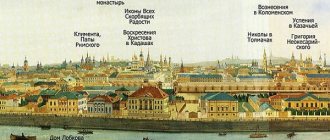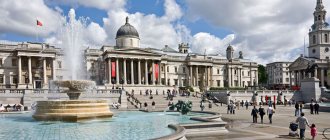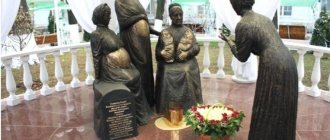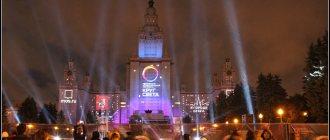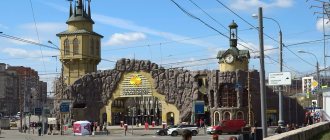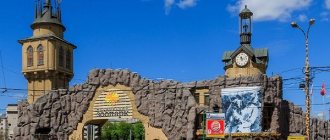Exertsirgauz, or simply Manege
From military drill to creative freedom. How did military parades in the Manege come to be replaced by art exhibitions? Which classic of Russian literature studied the bicycle in the building on Mokhovaya? On what occasion did Nikita Khrushchev say the famous phrase: “Our people don’t need this?” Answers to questions - in 10 facts from the history of the Moscow Manege.
A construction site against its will . The area where firewood, hay and moss were traded. That's why the street got the name Mokhovaya. The fire of 1812 that burned in Moscow destroyed merchant shops. On the site of the fire, Alexander I ordered the construction of an Exertsirhaus for two thousand soldiers - the House of Military Exercises was supposed to house an entire infantry regiment. They were preparing to celebrate the fifth anniversary of the victory in the Patriotic War with a review of troops. To receive the parade of the consolidated guards detachment of heroes, a building was built in the center of Moscow.
Augustine de Betancourt. Moscow Manezh. Watercolor. Around 1817
Manege and Kremlin Garden. Lithograph painted with watercolors. 1825. Pushkin Museum im. A.S. Pushkin
Maxim Vorobiev. View of the Manege, Kutafya Tower and St. Nicholas Church in Boots. Watercolor. 1817
Engineer and architect Betancourt . Not just an architect, but a mechanical engineer and organizer of the transport system of the Russian Empire, Augustin de Betancourt, took on the development of the project. The Russified Spaniard is the author of the famous fountain “Girl with a Jug” in Tsarskoye Selo. Betancourt founded the Institute of Railway Engineers, supervised the construction of the Nizhny Novgorod Fair, and designed a capstan - a device for lifting weights, which was used in the construction of St. Isaac's Cathedral. The Manege was built according to Betancourt's design.
Without a single column . Maneuvers without interference is the main task assigned to the architect. Under the roof there was to be a space of 6,500 square meters. The project turned out to be unprecedented: the width of the building was 45 meters - without internal supports! 30 wooden trusses rested only on the outer walls. Larch was chosen for construction - one of the most durable materials. The project was approved in the early summer of 1817, and completion of construction was expected in mid-autumn, by October 1. And the builders were on time.
Suspended ceiling . Know-how was used in the construction of the Manege - for the first time in Russia. The wooden ceiling beams were connected by a complex system that was adjusted with nuts. A military team looked after the miracle of engineering. Specialists monitored the serviceability of the rafters. The structure has survived to this day, although cracks appeared almost immediately after construction, which required reconstruction of the roof in 1819. A few years later, the number of rafters was increased to 45, and the architect Osip Bove, who was on the commission, added several details to the structure.
Manege. Perspective, section, plan, facade. Drawing from the album of Augustine de Betancourt. 1819
View of the Manege from Vozdvizhenka. Lithograph by Christoph Heizmann from a drawing by Eduard Gaertner. Mid-19th century
Roof trusses covering the Moscow Manege. 1917
Reconstructions . The author of the project for the Bolshoi Theater and the Arc de Triomphe decorated the building in the classicist style with stucco. Now the facades glorified the military power of Russia. The attributes of the Roman legionnaires were made according to Beauvais' designs. It never came to twelve cast-iron high reliefs “Military Armor” that were supposed to be placed in the piers. In 1838, a rotunda with the altar of the St. Nicholas Church in Sapozhka, dismantled on Trinity Square, was added to the Manege. But after the revolution, the extension was demolished to lay tram tracks along Manezhnaya Street.
Classic in Manege . "Moscow". This was the name of the club of cyclists or cyclists, which in 1899 organized a carnival in Manege. Here everyone was taught a newfangled hobby - cycling. Among the students was the writer Leo Tolstoy. The classic mastered the art of driving a two-wheeled vehicle already at an advanced age - at 67 years old. “During this time, I began to learn to ride a bicycle in the arena. It’s very strange why I’m drawn to do this,” Lev Nikolaevich wrote in his diary, continuing to master the vehicle with enthusiasm.
Denis Chernov. Moscow Manezh. 2012. Photo: dionisi.ru
Unknown artist. View of the side façade of the Manege from the Alexander Garden. Beginning of the 19th century
Alexander Garden in the 30–40s of the 19th century. On the right is the Manege building. Reproduction. State Historical Museum
Exhibitions
Since 1957, the building has hosted a huge number of exhibitions. Some of them created a real sensation. The notorious exhibition of avant-garde artists was severely criticized by N. Khrushchev, who visited the Manege on December 1, 1962. The head of state did not mince words. The result of the visit was the appearance of devastating articles in the media, which marked the beginning of a fight against a direction of art that was misunderstood by government officials.
© Olga Krivoschapova
In 1978, 400 works by Ilya Glazunov were presented in the Central Exhibition Hall of the Manege. In just thirty days, about half a million visitors came to look at the paintings. Interest was fueled, among other things, by forbidden topics touched upon by the artist in some of his works.
The exhibition about Orthodox Rus' and the history of the Romanovs, held in 2013, turned out to be so fascinating and in demand that the organizers had to extend its display several times. It included not only real exhibits, but also the use of multimedia devices to present materials.
Paintings in the exhibition hall, © Yuri Drachuk
The exhibition hall does not have its own displays. The collections presented on its premises change periodically.
Central Manege: exhibition schedule on the official website
Deadlock
In 1995, on the initiative of the then mayor of Moscow Yuri Luzhkov, one of the largest shopping and entertainment complexes in Europe was built on Manezhnaya Square - a complex with several underground floors. This threatened to subsidence the foundations of two historical buildings located nearby - the Moscow Hotel and the Manege. The hotel was urgently dismantled and rebuilt. During 1998-2001, a restoration project for the Manege was prepared, which included active commercial development of its underground space. In October 2003, the Moscow mayor's office held a competition for these works, which was won by the Austrian one. However, when concluding the contract, a problem arose: it turned out that Manege has the status of an architectural monument of federal significance, and the mayor’s office does not have the authority to dispose of it. The situation seemed insoluble. The Austrians who won the competition were left without a contract, the restoration of the Manege was postponed indefinitely, and the threat of subsidence of its foundation remained.
Gasoline cans
Researchers are still arguing about the causes of the fire. The main question: was the fire accidental or did someone set the Manege on fire? Over time, the arguments in favor of the first option weaken, and those in favor of the second become stronger. Even before the start of the investigation, Luzhkov confidently stated that the fire was caused by a wiring fault. But there was no wiring in the wooden roof slabs. The version of a firecracker thrown from the street was considered. But experts found that the attic of the building could not have caught fire either from her or from a left cigarette butt - the fire was preceded by a powerful release of thermal energy, which can only be created with the help of a flammable liquid. Moscow diggers who helped clear the rubble spoke about the discovery of several empty gasoline cans. Arson may also be indicated by the fact that the fire in the attic was spreading too quickly: at 21:00 the guards walked around the building and checked the upper rooms - everything was in order, there was no smell of smoke. And already at 21:15 the roof of the Manege was on fire, the fire area was about 500 square meters. Moreover, it is extremely difficult to set fire to thick boards treated with a special compound. As a result, the question still remains open. Yuri Luzhkov, dismissed by President Dmitry Medvedev in 2010 from the post of mayor of Moscow with the wording “due to loss of trust,” moved to Austria a few years later. And the main exhibition site in Moscow continues its successful work - both culturally and commercially.
Magazine: Secrets of the 20th Century No. 22, May 2021 Category: Unusual perspective Author: Margarita Kapskaya
Tags: Alexander I, Romanov era, Moscow, Secrets of the 20th century, fire, crime, building, arson, History of Moscow, manege, 2004
- Back
Tickets
The cost of entry to the Moscow Manege depends on the exhibitions or events being held, so it is not fixed. The list of categories of visitors entitled to benefits and free entry can be found on the official website of the complex.
Free admission to exhibitions at the Central Manege is possible on the third Sunday of every month.
When viewing temporary exhibitions, you can use the services of experienced guides. To participate, pre-registration is required by calling +7(499) 394-01-55. Groups of 5–20 people. Cost from 50 rubles per person.
Exhibitions at Central Exhibition Hall Manege
Content
- 1 Description of the Manege
- 2 History 2.1 Construction of Exerzirhaus
- 2.2 Improvements to the Manege
- 3.1 In tsarist times
- 4.1 Reconstruction plan under Luzhkov
- 5.1 Manual
Literature
- Budylina M.
History of the construction of the Manege in Moscow // Architectural Heritage: magazine. - M., 1952. - No. 2. - P. 236-249. - Vaskin A. A., Golstadt M. G.
From the demolished Voentorg to the burnt-out Manege. — M.: “Sputnik+”, 2009. — 397 p. — ISBN 978-5-9973-0100-2. - Vaskin A. A., Goldstadt M. G.
Old Moscow within the boundaries of the Kamer-Kollezhsky Val. Along silk Vozdvizhenka, along suede Manezhnaya: Photo guide. - M.: "Company Sputnik+", 2002. - 101 p. — ISBN 5-93406-348-0. - Veksler A. G.
Manezh and Manezhnaya Square in Moscow: horizons of history. - M.: Veche, 2012. - 143 p. — ISBN 978-5-9533-4664-1.
| Regulatory control | LCCN: nr98018815 VIAF: 132979864 ULAN: 500303190 WorldCat VIAF: 132979864 |
